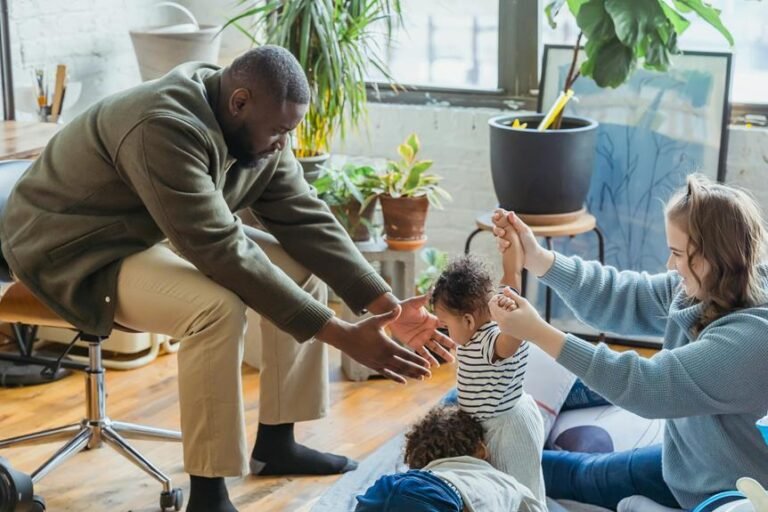Communication Strategies to Enhance Trust

To enhance trust through communication, prioritize openness, honesty, and reliability. Active listening techniques, such as reflective listening and asking open-ended questions, show engagement and value for others' opinions. Cultivate empathy and understanding through exercises and perspective-taking to deepen connections. Pay attention to nonverbal cues like body language and facial expressions for genuine communication. Transparency, honesty, and clear communication are essential for building trust and credibility. Consistency in communication and follow-up on promises strengthen reliability and accountability. Implementing these strategies fosters strong relationships and authenticity in interactions. Access the full potential of trust-building through effective communication strategies.
Key Takeaways
- Practice transparency and honesty in all communications.
- Demonstrate active listening to show engagement and understanding.
- Use nonverbal cues like open posture and nods for connection.
- Consistent communication builds reliability and trust over time.
- Follow-up and follow-through on commitments to show dedication.
Importance of Trust in Communication
Trust plays a pivotal role in effective communication, serving as the foundation upon which meaningful connections and relationships are built. Trust building is a continuous process that requires openness, honesty, and reliability. When trust is established, communication flows more smoothly, and individuals feel safe expressing themselves authentically. Effective communication isn't just about transmitting information; it's about creating an environment where all parties feel heard and understood.
In trust-building interactions, it's essential to demonstrate vulnerability and empathy. By showing vulnerability, you let others know that it's safe to be open and honest. Empathy allows you to understand others' perspectives, fostering a deeper connection.
Active listening techniques, such as paraphrasing and summarizing, are valuable tools in this process. These techniques demonstrate that you're fully engaged in the conversation, enhancing trust and rapport.
Active Listening Techniques
Utilizing active listening techniques is vital in enhancing communication by demonstrating your engagement and understanding in conversations. To truly engage in active listening, practice reflective listening where you paraphrase what the speaker has said to show your understanding. This technique not only confirms your comprehension but also reassures the speaker that you're fully present in the conversation.
Another essential aspect of active listening involves asking open-ended questions. These questions encourage the speaker to elaborate on their thoughts and feelings, fostering a deeper level of communication. By asking questions that require more than a simple yes or no answer, you demonstrate your interest in the speaker's perspective, building rapport and trust.
Incorporating these active listening techniques into your communication repertoire won't only enhance your relationships but also show others that you value their thoughts and opinions. Remember, active listening is a powerful tool that can transform the way you connect with those around you.
Building Empathy and Understanding
Enhancing communication through building empathy and understanding is essential for fostering meaningful connections and trust in relationships. To strengthen these bonds, engaging in empathy exercises and practicing perspective-taking techniques can be incredibly beneficial.
Empathy exercises involve actively listening to others without judgment, acknowledging their feelings, and trying to see the situation from their perspective. By doing so, you demonstrate that you genuinely care about their emotions and experiences, which can deepen your connection and trust with them.
Additionally, mastering perspective-taking techniques allows you to step into someone else's shoes mentally. This skill enables you to understand their thoughts, feelings, and motivations more clearly, enhancing your ability to communicate effectively and build trust.
Nonverbal Communication Cues
To effectively convey your intentions and emotions, paying attention to nonverbal communication cues is crucial in establishing a strong foundation for trust and understanding in your interactions.
Body language and facial expressions play a significant role in how your message is perceived by others. Your posture, gestures, eye contact, and even the subtle movements of your face can convey more meaning than words alone.
For instance, leaning in during a conversation can show attentiveness and interest, while avoiding eye contact might signal discomfort or dishonesty.
When engaging in conversations, be mindful of your nonverbal signals to make certain they align with your spoken words. Maintaining an open posture, nodding in agreement, and offering genuine smiles can help foster a sense of connection and trust.
Conversely, crossed arms, furrowed brows, or fidgeting may create barriers to effective communication and erode trust.
Transparency and Honesty
Pay attention to how you present yourself, as transparency and honesty are key pillars in building trust and fostering genuine connections in your interactions.
Open communication lays the groundwork for establishing trust. When you communicate openly, sharing information and thoughts honestly, you create a space where others feel comfortable doing the same. This transparency not only showcases your integrity but also encourages others to reciprocate, leading to stronger relationships.
Integrity and credibility go hand in hand with transparency. Being honest about your intentions, actions, and decisions showcases your integrity, while consistently following through on your promises builds credibility. When others perceive you as a person of integrity, they're more likely to trust you and engage in open communication.
In your interactions, aim to be transparent and honest. Embrace open communication, uphold your integrity, and maintain credibility. By doing so, you lay a solid foundation for trust to flourish, fostering genuine connections that are built on mutual respect and authenticity.
Conflict Resolution Strategies
Effective conflict resolution strategies are essential in fostering positive relationships and maintaining trust in communication dynamics. When conflicts arise, consider utilizing mediation techniques to facilitate open dialogue and understanding between parties.
De-escalation methods can help diffuse tense situations and guarantee that emotions don't hinder productive communication.
Collaborative problem-solving is another valuable approach to resolving conflicts. By working together towards a mutually beneficial solution, both parties can feel heard and respected.
Compromise strategies play a key role in finding common ground and reaching agreements that satisfy the needs of all involved.
Establishing Boundaries and Respect
Establishing clear boundaries and demonstrating mutual respect are foundational elements in cultivating trust and maintaining healthy communication dynamics. Setting limits allows both parties to understand each other's expectations and creates a safe space for open dialogue.
When you establish clear boundaries, you aren't only protecting your own needs but also showing respect for the other person's feelings and boundaries. This mutual respect forms the basis for trust building in any relationship.
By recognizing and honoring each other's boundaries, you convey that you value the other person's autonomy and well-being. This acknowledgment fosters a sense of safety and security, enabling meaningful connections to flourish.
When you approach interactions with a mindset of mutual respect, you create a harmonious environment where trust can grow organically.
Consistency and Follow-through
To sum up, demonstrating consistency and follow-through in your actions is crucial for establishing trust and credibility in your relationships. Accountability and reliability play a significant role in this process. When you consistently fulfill your promises and obligations, you demonstrate to others that you're dependable, which helps to cultivate trust. Individuals value those who possess the honesty to fulfill their commitments.
To bolster trust in your relationships, ensure that your actions are in harmony with your words. Consistent behavior reassures others of your reliability, laying a strong foundation for trust to develop. By showing dedication to your duties and upholding your promises, you exhibit your trustworthiness. This trustworthiness nurtures trust gradually, reinforcing the perception that you're a reliable individual.
To conclude, maintaining consistency and follow-through in your actions is a potent way to display your accountability, reliability, dedication, and honesty, ultimately strengthening the trust in your relationships.
Frequently Asked Questions
How Can Cultural Differences Impact Trust in Communication?
Cultural differences can create cross-cultural misunderstandings, impacting trust in communication. Language barriers may affect trust perceptions. It's important to navigate these challenges with empathy and open-mindedness to build strong, trusting relationships.
What Role Does Body Language Play in Building Trust?
When you engage with others, your body language speaks volumes. Nonverbal cues like eye contact, posture, and gestures can greatly influence trustworthiness perception. Pay attention to how you carry yourself – it shapes trust.
Can Trust Be Rebuilt After a Breach of Honesty?
Trust can be rebuilt after a breach of honesty through consistent actions that demonstrate sincerity and accountability. Rebuilding relationships requires open communication and transparency, gradually restoring credibility. It takes time, effort, and genuine commitment to regain trust.
How Do Personal Biases Affect Communication Trust?
Unconscious biases deeply influence trust dynamics in communication. Acknowledge your predispositions and actively work to counter them. By being aware of your biases, you can foster deeper connections built on understanding and respect.
Is It Possible to Regain Trust After a Conflict?
Yes, it's possible to regain trust after a conflict. Rebuilding relationships involves open dialogue, active listening, and genuine apologies. Communication recovery requires honesty, empathy, and consistent efforts to address concerns. Trust can be restored through patience and understanding.
Conclusion
To sum up, by implementing effective communication strategies such as active listening, empathy building, and transparency, trust can be enhanced in relationships and interactions.
Nonverbal cues, conflict resolution techniques, and setting boundaries also play a pivotal role in fostering trust.
Consistency and follow-through are key to maintaining trust over time.
Remember, communication is the foundation of trust, so utilize these strategies to strengthen your connections and relationships.
Trust is built on open and honest communication.







3 Comments